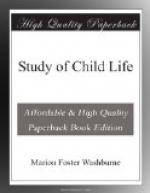The simple folk-songs of all nations, Eleanor Smith’s and most of Mrs. Gaynor’s songs, already mentioned, and the songs collected by Reinecke, called “Fifty Children’s Songs,” are excellent for this purpose. The old-fashioned nonsense songs, such as “Billy Boy,” “Mary had a Little Lamb” and “Hey Diddle Diddle, the Cat and the Fiddle,” may also have a pleasant and harmless place of their own.
Instrumental music should be on the same general order, not loud and showy, but clear, simple, sweet, and free from startling effects. Dashing pieces, rag-time pieces, marches, two-steps, and familiar tunes with variations, instead of bringing about a spirit of gentleness and harmony, actually tend to produce self-assertiveness and quarrelsomeness. Let any mother who does not believe this try the effort of an hour of the one kind of music on one evening, and an hour of the other kind on another evening. The difference will be immediately apparent.
[Sidenote: The Drama]
The influence of the drama must not be forgotten. This form of art, fallen so low among us since the time of the Puritans that it can scarcely be called an art at all, is, nevertheless, the art which perhaps above all others has an immediate and yet lasting influence. Children are themselves instinctively dramatic. They like to compose and act out all sorts of dramas of their own, from playing house (which is nothing but a drama prolonged from day to day), to such dramatic games as Statue-posing and Dumb Crambo. All children like to dress up, to wear masks, and to imitate the peculiarities of persons about them; to try on, as it were, the world as they see it, and discover thereby how the actors in it feel. Goethe’s Wilhelm Meister has already been referred to. In this—his great book on education—he practically bases all education upon the drama, and even throws the treatise itself into dramatic form.
This does not mean, however, that all children should be permitted to go to the theater as freely as they like. No; the plays which they compose and act for themselves have a far higher value educationally than most of the spectacular presentations of the old fairy tales with which they are usually regaled, and certainly more than the sensational melodramas which give them false ideas of art and morality. They should go sometimes to the theater to see really good and simple plays, but they should be oftener encouraged to get up for themselves plays at home. If, as they grow older, they are helped to think out their costumes with something of historical accuracy, to be true to the spirit and scenery of the times in which the representations are laid, the activity can be made to increase in value to them as the years go by. There is no other art, perhaps, by which the child so intimately links the world spirit with his own spirit. It is for this reason that the School of Education in the University of Chicago is equipped with small theaters in which the children act.




